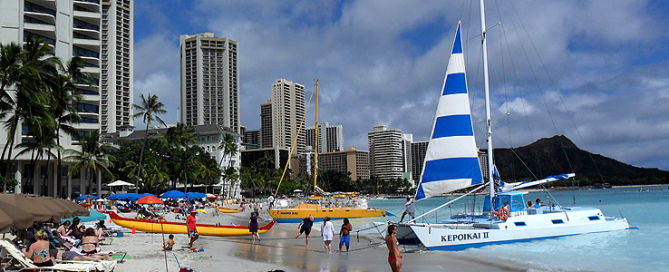June 3, 2012
Hawaii, 105,087 km
I flew from Samoa to the United States, and while the initial idea was to start cycling the continent from Alaska, the weather did not let me do so. It was the beginning of spring and according to my information, I had to wait a couple of months if I didn’t want to face the extreme weather conditions of the place. I imagine that at that time of the year only an Eskimo could survive in those latitudes travelling by bicycle, with a “made-in-china”-tent and my clothing. So, far from worrying about it, I stopped in Hawaii and then flew to San Francisco to ride the coast of California to get to Los Angeles, from where I finally flew to Alaska.
The Hawaiian archipelago consists of hundreds of islands, which extend over more than 2,000 km. Some of the main ones are: O’ahu, Maui, the Big Island and Kaua’i. The international flight from Samoa took me to the first one, the most populated island of the archipelago, internationally renowned for the military base Pearl Harbor and the famous Waikiki Beach.
Today Pearl Harbor is a U.S. naval base, the headquarters of the Pacific Fleet, where there is also a museum depicting the Japanese attack that brought the U.S. entry into World War II.
Waikiki is the main tourist centre of Hawaii. Located on the Southern coast of O’ahu, it concentrates 90% of the hotels.
Upon my arrival, the first thing that struck me was the number of people living on the street, “there are more than 6000 on the island” said Nick, “and they come from all corners of the country. The State Governments with colder weather send them by plane, because here the temperature in winter is tolerable for those who live on the street. Then they do not come back”. Almost everyone carries a shopping cart with their belongings, or they carry everything around on a bicycle. I was warned several times about the theft of bicycles, so I immediately bought a new lock; and although I paid 42 USD, the person who sold it to me assured that it was not 100% effective. “Welcome to America”, said Nick.
On my way to U.S. I decided to print another batch of my books in English. During my tour around Australia and New Zealand I sold them in the weekend markets and this covered my expenses and airfares. “The Highlight Moments”, I tell people who curiously approach the banner that I unfold next to my bike. I had been contacting several printers via internet and upon my arrival in Honolulu I had several books at Nick’s house, who I had contacted via warmshowers.org website. Nick was the first American in a long list of people who not only offered me hospitality, but also offered their time to help me with everything I needed: fixing my camera, getting a new phone number, getting bike parts, stove parts and opening an account at a bank, among other things.
Due to U.S. foreign policy and its strong presence in each of the countries I have visited over all these years, I must confess that I came to the United States with a certain prejudice against the “Americans”, as they are often called. But this did not last long, because within a few weeks of my stay I had been warmly welcomed by many people: first in Hawaii, then in California and later in Alaska (although I was told that such States are different…)
But in Hawaii, I also met the other kind of people, those who haven’t got wits. During the first weekend in Honolulu I went to the Farmer Market to sell my book, and there I found the dislike of his manager, who told me that only those who sell food could be part of the market. “There is no exception, you cannot stay here”, he replied.
Thus, during my stay in Honolulu nearly every afternoon I stopped in the main street of Waikiki Beach, and although it is forbidden to sell anything, nobody bothered me. Despite the large number of people passing by, sales were very low. “The economic crisis is punishing Americans like never before. The Americans are the new poor”, said a Colombian who has lived in the U.S. for many years.
During the last days of my stay I visited the beaches of Waimanalo, Kailua and Hoomaluhia Botanical Gardens. And it was then that I understood why Oahu is an international tourist destination with more than five million visitors each year.
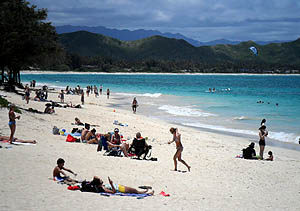
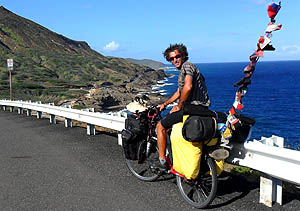
California, km 105.355
According to what I was told, California was inhabited thousands of years ago by native Americans, until the sixteenth century when early Spanish settlers started to arrive. Then, on the nineteenth century, when Mexico gained its independence, the area became one of its provinces along with Texas and New Mexico. But after the war with the U.S. (1846 – 1848) Mexico had to cede territory and shortly after California became the 31st State of the United States.
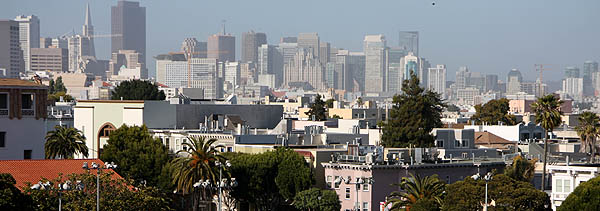
My first stop in California was San Francisco, for many the most beautiful and stunning city in North America, which historically has endeavoured to make room to tolerance and different groups.
In the ’50s the city witnessed the emergence of the beat generation, around the 60’s Haight Ashbury district became the hippie capital, and in the ’70s the first gay community – concentrated until today in the Castro neighbourhood- arouse which claimed for their rights. While riding along the streets I was surprised to see men sunbathing on the table of the bars, completely naked, as if nothing was happening around.
Since I was hosted in different neighbourhoods by several people I was able to feel the atmosphere of each of these places. The Mission District was the area I liked the most because of the great Spanish-speaking influence and presence.
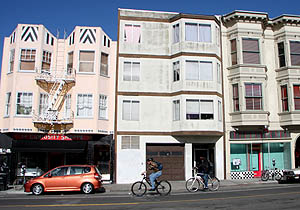
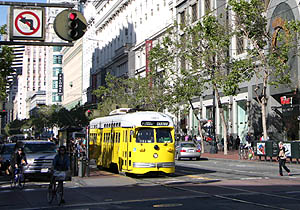
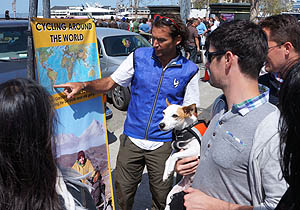
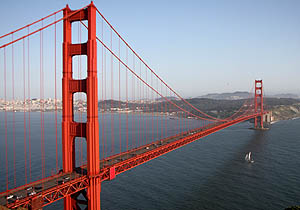
My stay in SF lasted two weeks. I went to a baseball stadium for the first time. Brad, who I had met in New Zealand months ago, took me to see the SF Giants. Then I visited Little Italy, the Financial District and the Golden Gate Bridge. When the police didn’t forbid me I would stop at the Embarcadero or Fisherman’s Wharf to sell my book. I got the impression that those officers, as good citizens of SF, also were tolerant with me. It was hard for me to leave the city because I made good friends and because its charm always seduced me.
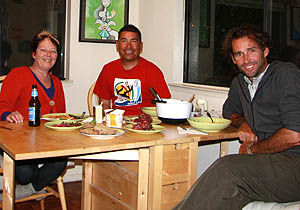
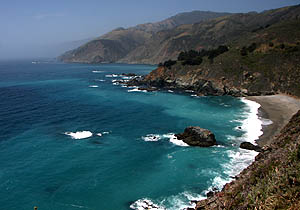
Riding around the State of California was easier than I imagined, the State has lots of camping sites where there are almost always special rates for those travelling by bike; and if not, I was well welcomed by local people, like Tito and the Gringa with whom I stayed in Salinas. “Salinas is one of the richest agricultural regions in California, the area produces a variety of fruit and vegetables; such as lettuce, strawberries, broccoli, carrots and spinach. The place is known as the world capital of salad, which is exported to the whole world”, the Gringa told me, who paradoxically only consumed organic products. During my tour of the area, I noticed people working in plantations wearing an astronaut garb. “Large producers have already sold their next two or three harvests, even at a higher price than in the market; that’s why they cannot fail. Thus, fertilizers, herbicides and pesticides, besides synthetic inputs become essential to their crops. They do not perform crop rotation for soil strengthening. People are aware of this, so in recent years organic food has become very popular in order to get a positive change in food consumption and due to the distrust in the safety and production of conventional food”, concluded the Gringa.
Monterey was another of my compulsory stops. As it was weekend, I stopped to sell the books. Latinos, mainly Mexicans, were the most curious and generous.
My journey continued through Big Sur province, a sparsely populated region in the central coast of California. The route along the sea has extraordinary views and crosses several State parks which have become popular tourist destinations. According to what I have been told property prices exceed USD 2 million.
On my way to Los Angeles, I went through San Luis Obispo, Avila Beach, and the beautiful beaches of Pismo and Grover. Then I visited Santa Barbara and I stopped at Ventura where I was welcomed by Mark, who encouraged me to approach the Headquarters of the clothing brand Patagonia. I was lucky, they treated me very well, and within a while, I got the clothes I needed.
I arrived in Los Angeles from Santa Monica riding along the beach, where the cult of body beauty is the main trend. During the weekend acrobats, skaters, bodybuilders, clowns, comedians, magicians and even sumo wrestlers, apart from those who practise conventional sports and dances, gather at Venice Beach. There are all sorts of characters. Moreover, in the Hollywood district there are imitators waiting for gratuity for each photo taken to them. The most famous ones are Spiderman, Ironman, Wonder Woman and Michel Jackson. People form a line. The Hollywood Blvd is a real circus.

I also visited the neighbourhood of the millionaires: Beverly Hills, the epicentre of luxury and abundance, where you can see mainly Roys Roll, BMW and Porsche.
During my stay in LA I visited each of the different markets that span the length and breadth of the city, and I sold my books only when I was allowed. After riding the South and West of the city, Los Angeles did not seem to me that chaotic and dangerous place I had been warned of, but rather a city that is well worth visiting.
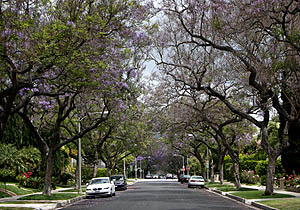
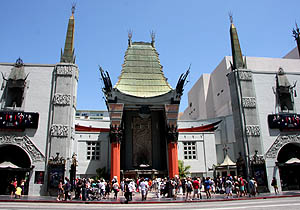
Thanks to Nick Blank, Deborah Agles, Ron Pimentel, Ludmila Santos and Dave Plaskett in Honolulu. Abel Molina, David Kroodsma, Brian Kliment and Brad Buckland in SF, Manuel Rubi in Santa Cruz, Tito y Gringa in Salinas, Steven Chauvet in Avila Beach, Mark Stevens in Ventura, Ajit Patel, Barry Brenner, David Vega, Reuben Reynoso, Patricio Alvarez and Hernan Montenegro in LA[:]


